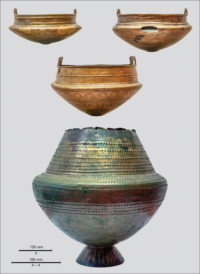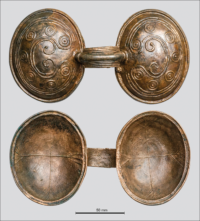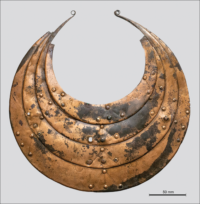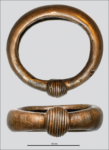 Two Late Bronze Age (1300–700 B.C.) metal hoards were discovered buried one on top of the other in the village of Kaliska, Poland. The largest of the two is one of the largest and most varied Bronze Age assemblages ever found in Pomerania, and that is saying something because more than 320 Bronze Age and Early Iron Age hoards have been unearthed there.
Two Late Bronze Age (1300–700 B.C.) metal hoards were discovered buried one on top of the other in the village of Kaliska, Poland. The largest of the two is one of the largest and most varied Bronze Age assemblages ever found in Pomerania, and that is saying something because more than 320 Bronze Age and Early Iron Age hoards have been unearthed there.
The details of both discoveries are murky because the finders illegally excavated the artifacts and then did their damnedest to deliberately obscure the facts of discovery and avoid surrendering the loot to cultural heritage authorities. The find first came to light in spring of 2017 when metal detectorists posted pictures of a large number of Bronze Age artifacts on a website. Authorities were alerted to the postings and pursued the finders who dodged them repeatedly. They also inaccurately reported where they had found the treasure. Eleven objects from the hoard were finally recovered in a police raid in June. The rest were handed over to a local museum in July.
 Later that year, word got out that a second hoard had been found in the same location. It too was a Late Bronze Age metal hoard, containing horse harness fittings, weapons, armor accessories and metal vessels, much of them copper. The landowner discovered the hoard under a boulder, dug it up, took it home and hid it. He was finally caught out that fall and the hoard confiscated. Three of the metal detectorists would later be convicted of illegally digging up an archaeological monuments. The landowner was also convicted of heritage crimes.
Later that year, word got out that a second hoard had been found in the same location. It too was a Late Bronze Age metal hoard, containing horse harness fittings, weapons, armor accessories and metal vessels, much of them copper. The landowner discovered the hoard under a boulder, dug it up, took it home and hid it. He was finally caught out that fall and the hoard confiscated. Three of the metal detectorists would later be convicted of illegally digging up an archaeological monuments. The landowner was also convicted of heritage crimes.
From what police and archaeologists have been able to piece together, the two discoveries were made back-to-back. First the farmer moved the boulder and found what would be dubbed Kaliska II, and then the metal detectorists snuck in after him, scanned the trench and found Kaliska I beneath it.
 Kaliska I consists of 124 artifacts, most of them bronze objects including vessels, collars, bracelets and buttons. Inside one of the vessels were organic artifacts — leather straps, wood elements — that survived in fragmentary condition thanks to the amateurish, ignorant and hasty excavation by the looters. Of particular note are a large, sheet-bronze vessels, three Nordic cast bronze vessels, four collars made from sickle-shaped rings, six crescent-shaped collars, 13 necklaces, five plate brooches, three dress clasps, five phalerae (disk-shaped horse harness decorations) 43 bracelets, seven of them kidney bracelets (oval bracelets worn on the arms that feature a kidney-shaped knob in the center). The quantity and nature of its contents makes Kaliska I unique in comparison to other Late Bronze Age hoards unearthed in Pomerania.
Kaliska I consists of 124 artifacts, most of them bronze objects including vessels, collars, bracelets and buttons. Inside one of the vessels were organic artifacts — leather straps, wood elements — that survived in fragmentary condition thanks to the amateurish, ignorant and hasty excavation by the looters. Of particular note are a large, sheet-bronze vessels, three Nordic cast bronze vessels, four collars made from sickle-shaped rings, six crescent-shaped collars, 13 necklaces, five plate brooches, three dress clasps, five phalerae (disk-shaped horse harness decorations) 43 bracelets, seven of them kidney bracelets (oval bracelets worn on the arms that feature a kidney-shaped knob in the center). The quantity and nature of its contents makes Kaliska I unique in comparison to other Late Bronze Age hoards unearthed in Pomerania.
 The style of the metalwork suggests the bronze artifacts date to the Bronze Age Period V (ca. 950–800/750 B.C.), but there is evidence that some of the objects were in use a little after that. Archaeologists estimate the hoard was probably buried in the second half of Period V (ca. 875–780/750 B.C.). The surviving organic elements provided a rare opportunity to get an absolute date for the hoard. The radiocarbon analysis results date the deposit of the Kaliska I hoard to between 790 and 740 B.C.
The style of the metalwork suggests the bronze artifacts date to the Bronze Age Period V (ca. 950–800/750 B.C.), but there is evidence that some of the objects were in use a little after that. Archaeologists estimate the hoard was probably buried in the second half of Period V (ca. 875–780/750 B.C.). The surviving organic elements provided a rare opportunity to get an absolute date for the hoard. The radiocarbon analysis results date the deposit of the Kaliska I hoard to between 790 and 740 B.C.